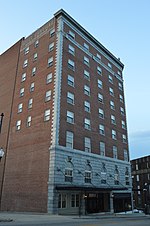Galileo Magnet High School

Galileo Magnet High School, opened in September 2002, is a public high school located in Danville, Virginia. The school was originally funded by an 8 million dollar grant to the Danville Public School System. By working directly with organizations such as the Langley Research Center and Virginia Tech, Galileo offers a technology-based curriculum, with three strands of study for students to choose from. A thematic-based curriculum is provided in Advanced Communications and Networking Technology, Air and Space Technology, and Biotechnology. U.S. News & World Report ranked the school the 45th best in the state in 2020.Galileo is an International Baccalaureate world school.
Excerpt from the Wikipedia article Galileo Magnet High School (License: CC BY-SA 3.0, Authors, Images).Galileo Magnet High School
South Ridge Street, Danville
Geographical coordinates (GPS) Address Nearby Places Show on map
Geographical coordinates (GPS)
| Latitude | Longitude |
|---|---|
| N 36.584888888889 ° | E -79.393444444444 ° |
Address
South Ridge Street 228
24541 Danville
Virginia, United States
Open on Google Maps









